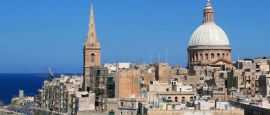Valletta History
With a history that includes sieges, Knights Hospitaller and a Nazi blitzkrieg, the story of Valletta’s past makes for fascinating reading. Born in 1565, following a siege that pitted the Knights Hospitaller (also known as the Knights of St John) against the might of the Ottoman Empire, the city was initially built with defence in mind.
Until the arrival of the Knights, Mount Sceberras, on which Valletta stands, was an arid tongue of land sitting between two harbours. Grand Master La Valette, the hero of the Great Siege, realised that if the Order was to maintain its hold on Malta, it had to provide defences. So he devised a plan for a new fortified city on the peninsula. Riches poured into Malta from European royals, much of which went into constructing the new city, called Valletta in honour of La Valette.
By the 16th century, Valletta had grown into Malta’s largest city, notable for its lavish palaces and graceful churches. Pretty though it was, defence remained the key consideration – and with good reason. In 1798, the French briefly occupied the city following the arrival of Napoleon Bonaparte who established a garrison on the island before leaving for Egypt. The Maltese resisted with the help of the British and two years later, the island became a British protectorate.
The now British island remained of key strategic importance, proving its worth again and again, most famously in 1942 when Valletta took a fearful pounding from a vastly superior force (this time the German Luftwaffe, which destroyed the Royal Opera House). The city held firm, earning the entire island an award for bravery in the process.
During the post-war years, the island achieved self-rule, becoming a constitutional monarchy with Queen Elizabeth II as head of state. It then eventually declared itself a republic. Today, Valletta is the smallest EU capital and Malta’s commercial and financial heart.
Did you know?
• Queen Elizabeth II lived in Valletta for almost two years.
• Valletta is the third capital city of Malta, following Mdina and Victoria.
• Valletta’s Manoel Theatre is one of the oldest in Europe.
Do you have any Feedback about this page?
© 2025 Columbus Travel Media Ltd. All rights reserved. No part of this site may be reproduced without our written permission, click here for information on Columbus Content Solutions.




 You know where
You know where